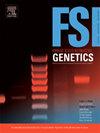皮肤微生物组的物种水平和 SNP 图谱分析提高了鉴别法证液体和个人的特异性
IF 3.1
2区 医学
Q2 GENETICS & HEREDITY
引用次数: 0
摘要
人体皮肤具有个体和体液特异性微生物特征,可能对法医鉴定有用。以往的研究大多是基于单个时间点微生物群的相对丰度来确定个体的属性,然而分类学和系统发育结构的波动可能会导致这种方法不可靠。在这项研究中,我们使用全长16S rRNA基因测序技术评估了个体手指、手掌、手臂和前额部位连续时间点的皮肤微生物组。在物种水平上,手部样本(手指、手掌、手臂)与前额微生物存在显著差异。此外,本研究的皮肤菌群明显不同于已报道的唾液、粪便和阴道分泌物样本中的优势物种。所有皮肤样本的ANOSIM分析显示个体间差异大于个体内差异,但个体识别的准确性仅为52.5 %。在微生物基因水平上,基于痤疮表皮杆菌的单核苷酸多态性(SNP)谱的三个机器学习模型导致超过97.5% %的个体的准确分类。这些结果表明,考虑细菌SNP图谱可能为法医鉴定提供新的方向,并在法医体液鉴定和个体鉴定中具有潜在的应用前景。本文章由计算机程序翻译,如有差异,请以英文原文为准。
Species level and SNP profiling of skin microbiome improve the specificity in identifying forensic fluid and individual
Human skin possesses individual and body fluid-specific microbial signatures potentially useful for forensic identification. Previous studies mostly attribute individuals based on the relative abundance of microbiota at single time point, however fluctuations in taxonomy and phylogenetic structure may cause this to be unreliable. In this study, we assessed the skin microbiome of individuals at consecutive time-point from fingers, palm, arm and forehead sites using full-length 16S rRNA gene sequencing. At the species level, hand samples (fingers, palm, arm) differed significantly from forehead microbes. Additionally, skin flora of the present study differed significantly from the dominant species that have been reported for saliva, feces, and vaginal secretions samples. ANOSIM analysis of all skin samples showed that inter-individual differences were greater than intra-individual differences, yet accuracy of individual identification was only 52.5 %. At the microbial gene level, three machine learning models based on single nucleotide polymorphism (SNP) profiles of Cutibacterium acnes resulted in accurate classification of more than 97.5 % individuals. These results indicate that consideration of bacterial SNP profiling may provide new directions for forensic identification and may have potential applications in body fluid identification and individual identification in forensic.
求助全文
通过发布文献求助,成功后即可免费获取论文全文。
去求助
来源期刊
CiteScore
7.50
自引率
32.30%
发文量
132
审稿时长
11.3 weeks
期刊介绍:
Forensic Science International: Genetics is the premier journal in the field of Forensic Genetics. This branch of Forensic Science can be defined as the application of genetics to human and non-human material (in the sense of a science with the purpose of studying inherited characteristics for the analysis of inter- and intra-specific variations in populations) for the resolution of legal conflicts.
The scope of the journal includes:
Forensic applications of human polymorphism.
Testing of paternity and other family relationships, immigration cases, typing of biological stains and tissues from criminal casework, identification of human remains by DNA testing methodologies.
Description of human polymorphisms of forensic interest, with special interest in DNA polymorphisms.
Autosomal DNA polymorphisms, mini- and microsatellites (or short tandem repeats, STRs), single nucleotide polymorphisms (SNPs), X and Y chromosome polymorphisms, mtDNA polymorphisms, and any other type of DNA variation with potential forensic applications.
Non-human DNA polymorphisms for crime scene investigation.
Population genetics of human polymorphisms of forensic interest.
Population data, especially from DNA polymorphisms of interest for the solution of forensic problems.
DNA typing methodologies and strategies.
Biostatistical methods in forensic genetics.
Evaluation of DNA evidence in forensic problems (such as paternity or immigration cases, criminal casework, identification), classical and new statistical approaches.
Standards in forensic genetics.
Recommendations of regulatory bodies concerning methods, markers, interpretation or strategies or proposals for procedural or technical standards.
Quality control.
Quality control and quality assurance strategies, proficiency testing for DNA typing methodologies.
Criminal DNA databases.
Technical, legal and statistical issues.
General ethical and legal issues related to forensic genetics.

 求助内容:
求助内容: 应助结果提醒方式:
应助结果提醒方式:


